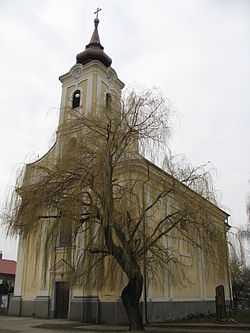Vojka nad Dunajom
| Vojka nad Dunajom Vajka | ||
|---|---|---|
| village | ||
 | ||
| ||
 | ||
| Coordinates: 47°58′00″N 17°23′00″E / 47.96667°N 17.38333°ECoordinates: 47°58′00″N 17°23′00″E / 47.96667°N 17.38333°E | ||
| Country |
| |
| Region | Trnava | |
| District | Dunajská Streda | |
| First written mention | 1186 | |
| Government | ||
| • Mayor | Donald Álló[1][2] (Ind.) | |
| Area | ||
| • Total | 8.21 km2 (3.17 sq mi) | |
| Elevation | 122 m (400 ft) | |
| Population (2001)[3] | ||
| • Total | 432 | |
| • Estimate (2008) | 467 | |
| • Density | 57/km2 (150/sq mi) | |
| Ethnicity[3] | ||
| • Hungarians | 87,73% | |
| • Slovakians | 11,81% | |
| Time zone | EET (UTC+1) | |
| • Summer (DST) | EEST (UTC+2) | |
| Postal Code | 930 31 | |
| Area code(s) | +421 31 | |
| Website | village website | |
Vojka nad Dunajom (Hungarian: Vajka, Hungarian pronunciation:[’vɒjkɒ]) is a village and municipality in the Dunajská Streda District in the Trnava Region of south-west Slovakia.
History
In the 9th century, the territory of Vojka nad Dunajom became part of the Kingdom of Hungary. In historical records the village was first mentioned in 1186. After the Austro-Hungarian army disintegrated in November 1918, Czechoslovak troops occupied the area, later acknowledged internationally by the Treaty of Trianon. Between 1938 and 1945 Vojka nad Dunajom once more became part of Miklós Horthy's Hungary through the First Vienna Award. From 1945 until the Velvet Divorce, it was part of Czechoslovakia. Since then it has been part of Slovakia.
Geography
The municipality lies at an altitude of 123 metres and covers an area of 8.212 km². In 2008 t had an estimated population of 467 people.
It is situated on an island between the (old) Danube and the "new Danube", i.e. the Danube channel created by the Gabčíkovo waterworks.
